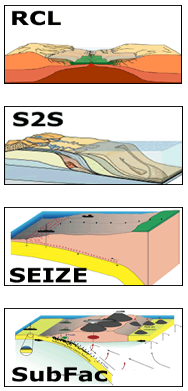About MARGINS Initiatives
Rupturing Continental Lithosphere

×
- How does the strength of the lithosphere evolve during rupturing?
- How is strain partitioned during lithospheric rupturing?
- What is the role of magmatism (and volatiles) during extension and in the transition to sea-floor spreading and what is the relationship between magma petrogenesis and the deformation magnitude and history?
- What is the stratigraphic response to lithospheric rupturing?
- How are fluid fluxes modified or controlled by lithospheric rupturing?
Source to Sink
S2S addresses the following fundamental questions:
- What processes control the rate of sediment and solute production in a dispersal system?
- How does transport through the system alter the magnitude, grain size, and delivery rate to sediment sinks?
- How is variability of sediment production, transport, and accumulation in a dispersal system preserved by the stratigraphic record?
Seismogenic Zone Experiment
SEIZE addresses the following questions:
- What is the nature of strong, locked parts of seismogenic zones?
- What are the temporal relationships among stress, strain, and fluid composition throughout the earthquake cycle?
- What controls the up- and down-dip limits of the seismogenic zone?
- What is the nature of tsunamigenic earthquake zone?
- What is the role of large thrust earthquakes in mass flux of material in the subduction system?
Subduction Factory
SubFac addresses three fundamental science themes:
- How do forcing functions such as convergence rate and upper plate thickness regulate production of magma and fluid from the Subduction Factory?
- How does the volatile cycle (H2O and CO2) impact chemical, physical and biological processes from trench to deep mantle?
- What is the mass balance of chemical species and material across the Subduction Factory, and how does this balance affect continental growth and evolution?
